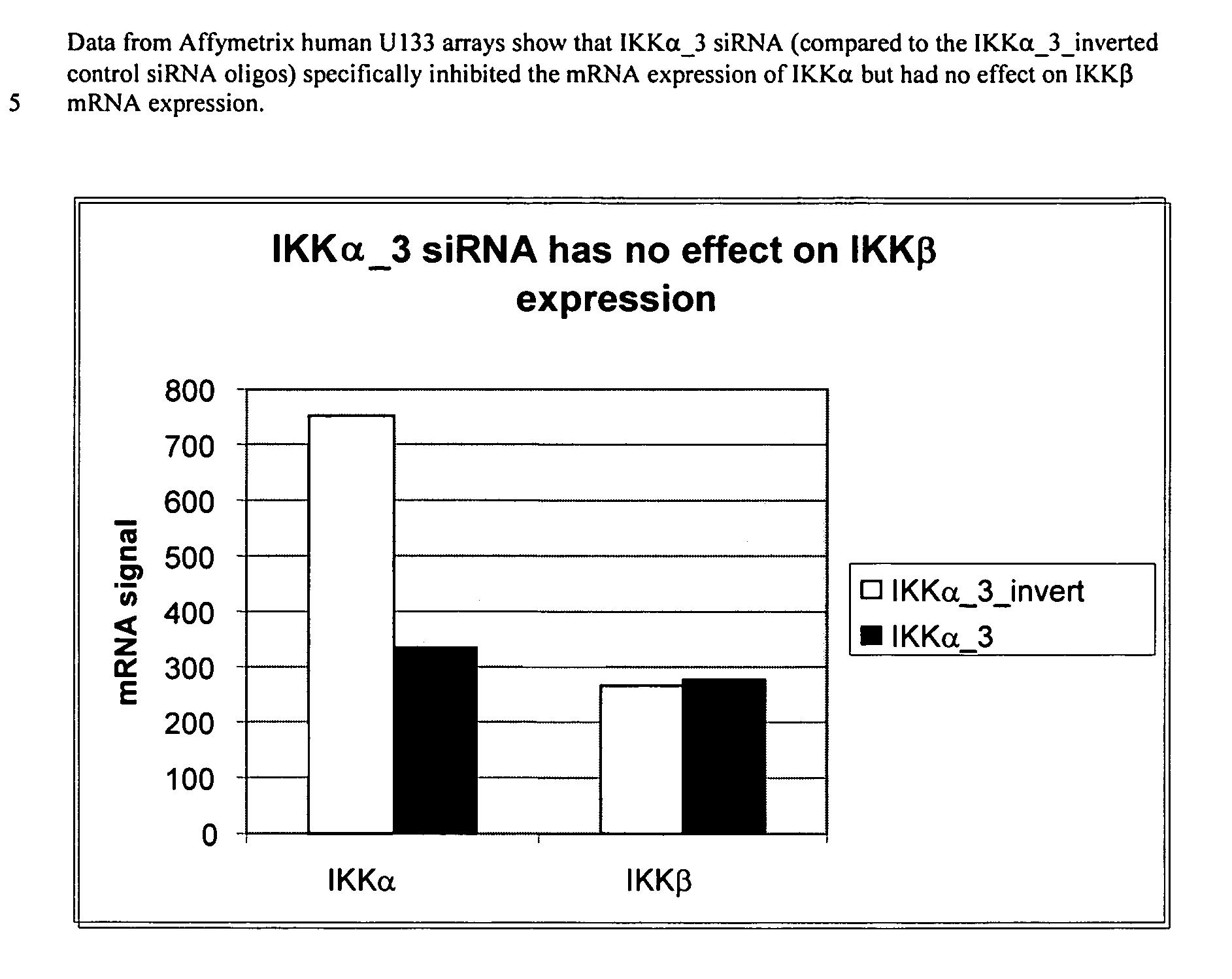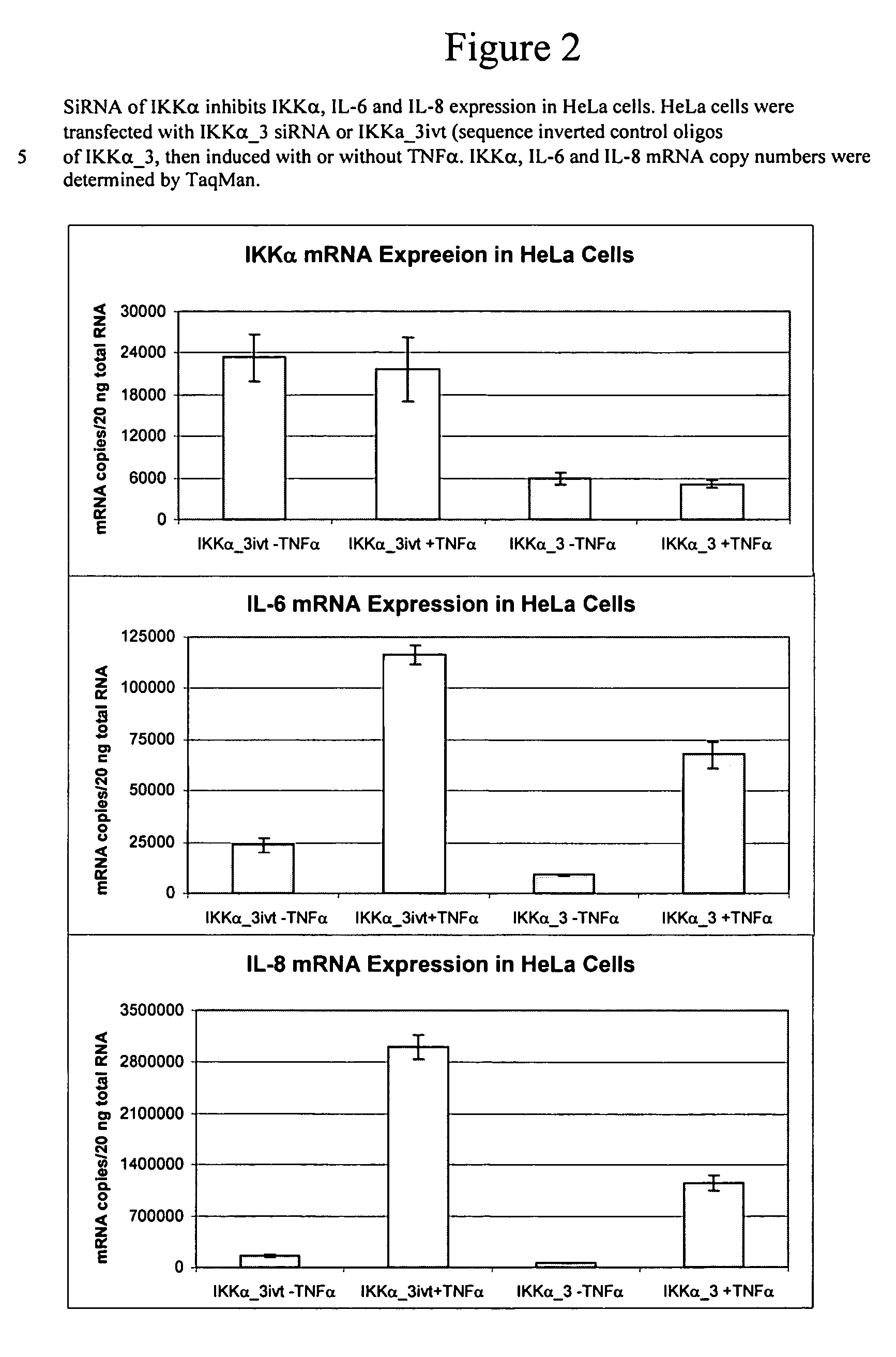Methods for modulating IKKα activity
a technology of ikk activity and ikk, applied in the field of ikk activity modulation, can solve problems such as effective gene silencing, and achieve the effects of reducing the effect of tnf induced genes, reducing ikk activity, and reducing the effect of nf-b induced gene transcription
- Summary
- Abstract
- Description
- Claims
- Application Information
AI Technical Summary
Benefits of technology
Problems solved by technology
Method used
Image
Examples
example 1
Preparation of siRNA Duplexes.
[0083]SiRNA directed to IKKα sequence was designed according to the technique described by Tuschl. Elbashir S M et al, Nature 2001, 411, 494–498. SiRNA duplexes composed of 21 nt sense and 21 nt antisense strands, paired in a manner to have a 2-nt 3′ overhang were used. The sequence of the 2-nt overhang is thought to make a contribution to the specificity of the target recognition restricted to the unpaired nucleotide adjacent to the first base pair. 2-Deoxynucleotides were used in the 3′ overhang.
[0084]The targeted region was selected from the cDNA for human IKKα shown in SEQ. ID No. 1 beginning 100 nt downstream of the start codon. Sequences were searched for AA(N19)TT and with approximately 50% G / C content. The sequence of the sense siRNA corresponded to (N19)TT to N21, respectively. The 3′ end of the sense RNA was converted to TT. A blast search was performed on the selected siRNA against EST libraries to ensure that only one gene was targeted. The ...
example 2
Delivery of siRNA to HeLa Cells
Transfection of siRNA Duplexes
[0086]Delivery of siRNA duplexes was performed with OLIGOFECTAMINE™ reagent available from Invitrogen (Carlsbad, Calif.). The samples were prepared in a 6 well format. Transfection efficiencies were found to be about 80%.
[0087]For each well of a 6 well plate, one tube containing 10 μl of 20 μM siRNA duplex with 90 μl of Opti-MEM, and in a separate tube 4 μl of OLOGOFECTAMIN™ reagent with 96 μl of Opti-MEM were mixed and incubated for 7–10 minutes at room temperature. The two tubes were combined and incubated for another 20 to 25 minutes at room temperature. Then 800 μl of fresh Opti-MEM was added to obtain a final solution of 1000 μl. Then 1000 μl of siRNA-OLIGOFECTAMINE™ was added to cultured cells (40 to 50% confluent). The cells were seeded the previous day in 6-well plates at a density of 2×105 cells / well using 2 ml of DMEM tissue culture medium supplemented with 10% FBS without antibiotics. The control used for transf...
example 3
Preparation of RNA and PCR Primers
[0088]Total RNA was prepared from the cells 2 days after delivery of siRNA's. Total cellular RNA was isolated from tissue or cell samples using the RNeasy™ kit and Rnase-Free DNase Set Protocol from Qiagen (Valencia, Calif.) according to the manufacturer's directions. PCR primers and TaqMan probes were designed using Primer Express 1.5 Software (Applied Biosystems, Foster, Calif.). The sequence of the PCR primers used were SEQ. ID. No. 9: 5′-GCACAGAGATGGTGAAAATCATTG-3′, and SEQ. ID. No. 10: 5′-CAACTTGCTCAAATGACCAAACAG-3′. The probe sequence SeQ. ID No. 11: 5′-TGAGCACACGGTCCTGACTCTGCA labeled with a reporter fluorescent dye, FAM (6-carboxyfluorescein), at the 5′ end and a fluorescent dye quencher TAMRA (6-carboxy-tetramethyl-rhodamine) at the 3′ end. The specificity of PCR primers was tested under normal PCR conditions in a thermal cycler prior to TaqMan™ PCR quantitation. Total cellular RNA was isolated from cell samples using the RNeasy Kits and RN...
PUM
| Property | Measurement | Unit |
|---|---|---|
| temperature | aaaaa | aaaaa |
| temperature | aaaaa | aaaaa |
| volume | aaaaa | aaaaa |
Abstract
Description
Claims
Application Information
 Login to View More
Login to View More - R&D
- Intellectual Property
- Life Sciences
- Materials
- Tech Scout
- Unparalleled Data Quality
- Higher Quality Content
- 60% Fewer Hallucinations
Browse by: Latest US Patents, China's latest patents, Technical Efficacy Thesaurus, Application Domain, Technology Topic, Popular Technical Reports.
© 2025 PatSnap. All rights reserved.Legal|Privacy policy|Modern Slavery Act Transparency Statement|Sitemap|About US| Contact US: help@patsnap.com



